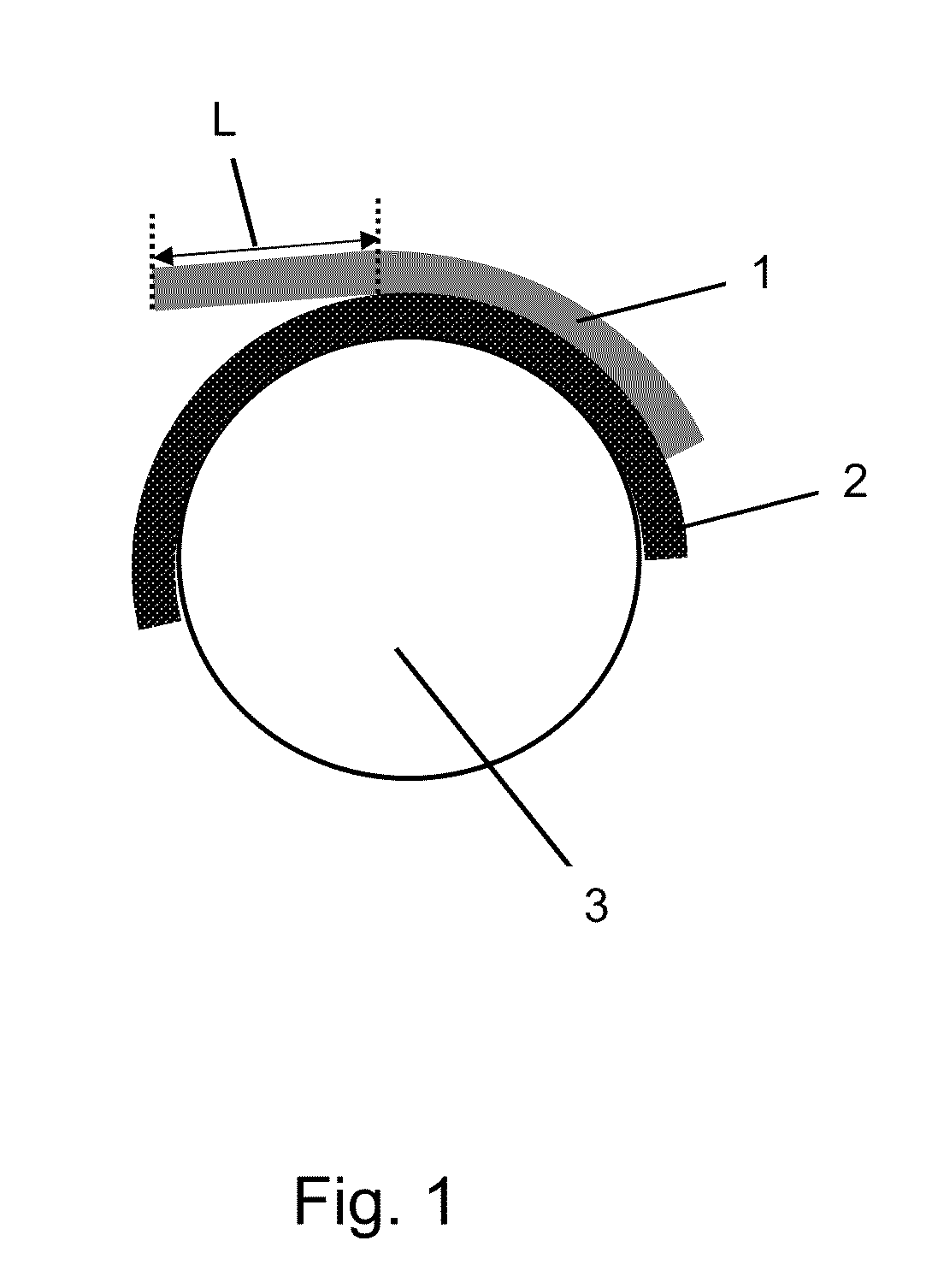Pressure-sensitive adhesives for bonding printing plates
a technology of pressure-sensitive adhesives and printing plates, which is applied in the direction of adhesive types, printing, lamination, etc., can solve the problems of affecting the bonding edge of the plate on the pressure-sensitive adhesive tape, the failure of the adhesive bond in contact with solvents that may penetrate the bonded joint, and the risk of damaging the expensive printing plate. , the risk of extra expense and effor
- Summary
- Abstract
- Description
- Claims
- Application Information
AI Technical Summary
Benefits of technology
Problems solved by technology
Method used
Image
Examples
example 1
[0051]A 2 L glass reactor conventional for free-radical polymerizations was charged with 20.0 g of acrylic acid, 99.2 g of 2-ethylhexyl acrylate, 280.8 g of butyl acrylate, 150.0 g of acetone and 150.0 g of special-boiling-point spirit 60 / 95. After nitrogen gas had been passed through it for 45 minutes of stirring, the reactor was heated to 58° C. and 0.16 g of 2,2′-azodi(2-methylbutyronitrile) (Vazo 67, DuPont) in solution in 10 g of acetone was added. Subsequently the external heating bath was heated to 75° C. and the reaction was carried out constantly with evaporative cooling (external temperature 75° C.). After a reaction time of one hour, 0.24 g of 2,2′-azodi(2-methylbutyronitrile) (Vazo 67, DuPont) in solution in 10 g of acetone was added. After three hours, the batch was diluted with 45 g of acetone and 45 g of special-boiling-point spirit 60 / 95. After a reaction time of five hours and 30 minutes, 0.60 g of bis(4-tert-butylcyclohexanyl)peroxydicarbonate (Perkadox 16, Akzo No...
example 2
[0053]A 2 L glass reactor conventional for free-radical polymerizations was charged with 28.0 g of acrylic acid, 97.2 g of 2-ethylhexyl acrylate, 274.8 g of butyl acrylate, 150.0 g of acetone and 150.0 g of special-boiling-point spirit 60 / 95. After nitrogen gas had been passed through it for 45 minutes of stirring, the reactor was heated to 58° C. and 0.16 g of 2,2′-azodi(2-methylbutyronitrile) (Vazo 67, DuPont) in solution in 10 g of acetone was added. Subsequently the external heating bath was heated to 75° C. and the reaction was carried out constantly with evaporative cooling (external temperature 75° C.). After a reaction time of one hour, 0.24 g of 2,2′-azodi(2-methylbutyronitrile) (Vazo 67, DuPont) in solution in 10 g of acetone was added. After three hours, the batch was diluted with 45 g of acetone and 45 g of special-boiling-point spirit 60 / 95. After a reaction time of five hours and 30 minutes, 0.60 g of bis(4-tert-butylcyclohexanyl)peroxydicarbonate (Perkadox 16, Akzo No...
example 3
[0055]A 2 L glass reactor conventional for free-radical polymerizations was charged with 36.0 g of acrylic acid, 95.2 g of 2-ethylhexyl acrylate, 268.8 g of butyl acrylate, 150.0 g of acetone and 150.0 g of special-boiling-point spirit 60 / 95. After nitrogen gas had been passed through it for 45 minutes of stirring, the reactor was heated to 58° C. and 0.16 g of 2,2′-azodi(2-methylbutyronitrile) (Vazo 67, DuPont) in solution in 10 g of acetone was added. Subsequently the external heating bath was heated to 75° C. and the reaction was carried out constantly with evaporative cooling (external temperature 75° C.). After a reaction time of one hour, 0.24 g of 2,2′-azodi(2-methylbutyronitrile) (Vazo 67, DuPont) in solution in 10 g of acetone was added. After three hours, the batch was diluted with 45 g of acetone and 45 g of special-boiling-point spirit 60 / 95. After a reaction time of five hours and 30 minutes, 0.60 g of bis(4-tert-butylcyclohexanyl)peroxydicarbonate (Perkadox 16, Akzo No...
PUM
| Property | Measurement | Unit |
|---|---|---|
| Temperature | aaaaa | aaaaa |
| Fraction | aaaaa | aaaaa |
| Fraction | aaaaa | aaaaa |
Abstract
Description
Claims
Application Information
 Login to View More
Login to View More - R&D
- Intellectual Property
- Life Sciences
- Materials
- Tech Scout
- Unparalleled Data Quality
- Higher Quality Content
- 60% Fewer Hallucinations
Browse by: Latest US Patents, China's latest patents, Technical Efficacy Thesaurus, Application Domain, Technology Topic, Popular Technical Reports.
© 2025 PatSnap. All rights reserved.Legal|Privacy policy|Modern Slavery Act Transparency Statement|Sitemap|About US| Contact US: help@patsnap.com


